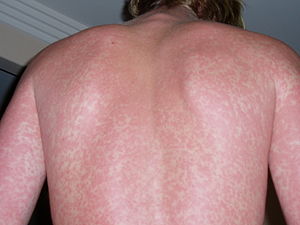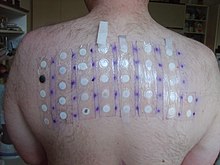Rash
| Rash | |
|---|---|
 | |
| A diffuse rash on the back of a male | |
| Classification and external resources | |
| Specialty | Dermatology |
ICD-10 | R21 |
ICD-9-CM | 782.1 |
| DiseasesDB | 25831 |
| MedlinePlus | 003220 |
| MeSH | D005076 |
A rash is a change of the human skin which affects its color, appearance, or texture.
A rash may be localized in one part of the body, or affect all the skin. Rashes may cause the skin to change color, itch, become warm, bumpy, chapped, dry, cracked or blistered, swell, and may be painful.
The causes, and therefore treatments for rashes, vary widely. Diagnosis must take into account such things as the appearance of the rash, other symptoms, what the patient may have been exposed to, occupation, and occurrence in family members. The diagnosis may confirm any number of conditions.
The presence of a rash may aid diagnosis; associated signs and symptoms are diagnostic of certain diseases. For example, the rash in measles is an erythematous, morbilliform, maculopapular rash that begins a few days after the fever starts. It classically starts at the head, and spreads downwards.
Contents
1 Differential diagnosis
1.1 Conditions
2 Diagnostic approach
3 Treatment
4 References
5 External links
Differential diagnosis
Common causes of rashes include:
- Food allergy
Medication side effects[1][2]
- Anxiety
- Allergies, for example to food, dyes, medicines, insect stings, metals such as zinc or nickel; such rashes are often called hives.
- Skin contact with an irritant
Fungal infection, such as ringworm
Balsam of Peru[3]
- Reaction to vaccination
- Skin diseases such as eczema or acne
- Exposure to sun (sunburn) or heat
Friction due to chafing of the skin
Irritation such as caused by abrasives impregnated in clothing rubbing the skin. The cloth itself may be abrasive enough for some people- Secondary syphilis
- Poor personal hygiene
Uncommon causes:
Autoimmune disorders such as psoriasis
- Lead poisoning
- Pregnancy
- Repeated scratching on a particular spot
- Lyme disease
- Scarlet fever
Conditions
| Skin disease | Symptoms | Usual area of body |
|---|---|---|
Acne vulgaris | Comedones, papules, pustules and nodules. | Face, chest and back. |
| Acne rosacea | Flushed appearance or redness. | Cheeks, chin, forehead or nose. |
Boil | Painful red bump or a cluster of painful red bumps | Anywhere |
Cellulitis | Red, tender and swollen areas of skin | Around a cut, scrape or skin breach |
Insect bite | Red and/or itchy bumps on the skin | Anywhere and can be sprinked randomly |
Allergic reaction | Irregular, raised or flat red sores that appeared after taking medicine/drugs or eating certain foods | Anywhere |
Hidradenitis Supportiva | Deep sebum filled cystic condition of apocrine gland overstimulation, caused by many internal and external factors eg, stress, toxic environmental overload and immune impairment. | See Hidradenitis. |
Hives | Bumps formed suddenly | Anywhere but usually first noticed on face |
Seborrheic dermatitis | Bumps and swelling | Near glands |
Cradle Cap | Dry, scaly skin | Scalp of recently born babies |
Irritant contact dermatitis | Red, itchy, scaly, or oily rash | Eyebrows, nose, edge of the scalp, point of contact with jewellery, perfume, or clothing. |
Allergic Contact Dermatitis caused by poison ivy, poison oak, sumac, or Balsam of Peru[3] | Red, itchy, scaly or oily rash; can also be weeping or leathery. | Anywhere that came in contact with the irritant either directly or via transfer (e.g. from contaminated clothing.) |
Allergic purpura | Small red dots on the skin, or larger, bruise-like spots that appeared after taking medicine | Anywhere |
Pityriasis Rosea | Started with a single scaly, red and slightly itchy spot, and within a few days, did large numbers of smaller patches of the rash, some red and/or others tan | Chest and abdomen |
Dermatitis herpetiformis | Intensely itchy rash with red bumps and blisters | Elbows, knees, back or buttocks |
Erythema nodosum | Large red bumps that seem to bruise and are tender to touch | Anywhere |
Psoriasis | White, scaly rash over red, flaky, irritated skin | Elbows and knees |
Erythema multiforme | Red, blotchy rash, with "target like" hives or sores. | Anywhere |
Measles | Red rash that is raised with a fever or sore throat. | Usually starts first on the forehead and face and spreads downward. |
Chickenpox | Multiple blisters with a fever, cough, aches, tiredness and sore throat. | Usually starts first on the face, chest and back and spreads downward. |
Shingles | Red blisters that are very painful and may crust | Anywhere |
Fifth Disease | Started as a fever and then developed a bright red rash | Cheeks |
Warts | Soft bumps forming that don't itch and have no other symptoms | Anywhere |
Ringworm | Bald spot on the scalp or a ring of itchy red skin | Anywhere |
Syphilis | Rash that is red but not itchy | Palms of hands or soles of feet |
Jock itch, yeast infection or diaper rash | Red itchy rash | Groin |
Tinea versicolor | Light coloured patches | Anywhere |
Impetigo | Crusted, tan-colored sores | Near nose or lip |
Scabies | Bite-like sores that itch and spread intensely | Usually start on hands or feet and spread everywhere |
Rocky Mountain spotted fever | A fine rash with a fever and headache | Usually start on arms and legs including the hands and feet |
Lupus erythematosus | A butterfly rash with achy joints | Forehead and cheeks |
Jaundice or sign of hepatitis | Yellowish | Skin, whites of eyes and mouth |
Bruise | Blue or black area after being hit | Anywhere |
Actinic keratoses | Scaly, pink, gray or tan patches or bumps | Face, scalp or on the backs or the hands |
Keloid or hypertrophic scar | Scar that has grown larger than expected | Anywhere |
Lipoma | Soft or rubbery growth | Anywhere |
Milia | Lots of white spots | On the face of a baby |
Molluscum or contagiosum | Small, firm, round bumps with pits in the center that may sit on tiny stalks | Anywhere |
Scarlet fever | Becomes confluent and forms bright red lines in the skin creases of the neck, armpits and groins (Pastia's lines) | Face, chest & back, whole body, armpits, inside elbows, groins |
Sebaceous cyst | Bump with a white dome under the skin | Scalp, nape of the neck or upper back |
Skin tag | Soft, fleshy growth, lump or bump | Face, neck, armpits or groin |
Xanthelasma | Yellow area under the skin | Under eyelids |
Melanoma | Dark bump that may have started within a mole or blemish, or, a spot or mole that has changed in color, size, shape or is painful or itchy | Anywhere |
Basal cell carcinoma | Fleshy, growing mass | Areas exposed to the sun |
Squamous cell carcinoma | Unusual growth that is red, scaly or crusted | Face, lip or chin |
Kaposi's sarcoma | Dark or black raised spots on the skin that keep growing or have appeared recently | Anywhere |
Erythema annulare centrifugum (EAC) | Pink-red ring or bullseye marks | Anywhere |
Diagnostic approach

Patch test
The causes of a rash are numerous, which may make the evaluation of a rash extremely difficult. An accurate evaluation by a provider may only be made in the context of a thorough history (What medication is the patient taking? What is the patient's occupation? Where has the patient been?) and complete physical examination.
Points to note in the examination include:
- The appearance: e.g., purpuric (typical of vasculitis and meningococcal disease), fine and like sandpaper (typical of scarlet fever); circular lesions with a central depression are typical of molluscum contagiosum (and in the past, small pox); plaques with silver scales are typical of psoriasis.
- The distribution: e.g., the rash of scarlet fever becomes confluent and forms bright red lines in the skin creases of the neck, armpits and groins (Pastia's lines); the vesicles of chicken pox seem to follow the hollows of the body (they are more prominent along the depression of the spine on the back and in the hollows of both shoulder blades); very few rashes affect the palms of the hands and soles of the feet (secondary syphilis, rickettsia or spotted fevers,[4]guttate psoriasis, hand, foot and mouth disease, keratoderma blennorrhagicum);
- Symmetry: e.g., herpes zoster usually only affects one side of the body and does not cross the midline.
A patch test may be ordered, for diagnostic purposes.[5]
Treatment
Treatment differs according to whichrash a patient has been diagnosed with. Common rashes can be easily remedied using steroid topical creams (such as hydrocortisone) or non-steroidal treatments. Many of the medications are available over the counter in the United States.[6]
The problem with steroid topical creams i.e. hydrocortisone; is their inability to penetrate the skin through absorption and therefore not be effective in clearing up the affected area, thus rendering the hydrocortisone almost completely ineffective in all except the most mild of cases.[7]
References
^ "Eszopiclone" (PDF). F.A. Davis. 2017. Retrieved April 15, 2017..mw-parser-output cite.citation{font-style:inherit}.mw-parser-output .citation q{quotes:"""""""'""'"}.mw-parser-output .citation .cs1-lock-free a{background:url("//upload.wikimedia.org/wikipedia/commons/thumb/6/65/Lock-green.svg/9px-Lock-green.svg.png")no-repeat;background-position:right .1em center}.mw-parser-output .citation .cs1-lock-limited a,.mw-parser-output .citation .cs1-lock-registration a{background:url("//upload.wikimedia.org/wikipedia/commons/thumb/d/d6/Lock-gray-alt-2.svg/9px-Lock-gray-alt-2.svg.png")no-repeat;background-position:right .1em center}.mw-parser-output .citation .cs1-lock-subscription a{background:url("//upload.wikimedia.org/wikipedia/commons/thumb/a/aa/Lock-red-alt-2.svg/9px-Lock-red-alt-2.svg.png")no-repeat;background-position:right .1em center}.mw-parser-output .cs1-subscription,.mw-parser-output .cs1-registration{color:#555}.mw-parser-output .cs1-subscription span,.mw-parser-output .cs1-registration span{border-bottom:1px dotted;cursor:help}.mw-parser-output .cs1-ws-icon a{background:url("//upload.wikimedia.org/wikipedia/commons/thumb/4/4c/Wikisource-logo.svg/12px-Wikisource-logo.svg.png")no-repeat;background-position:right .1em center}.mw-parser-output code.cs1-code{color:inherit;background:inherit;border:inherit;padding:inherit}.mw-parser-output .cs1-hidden-error{display:none;font-size:100%}.mw-parser-output .cs1-visible-error{font-size:100%}.mw-parser-output .cs1-maint{display:none;color:#33aa33;margin-left:0.3em}.mw-parser-output .cs1-subscription,.mw-parser-output .cs1-registration,.mw-parser-output .cs1-format{font-size:95%}.mw-parser-output .cs1-kern-left,.mw-parser-output .cs1-kern-wl-left{padding-left:0.2em}.mw-parser-output .cs1-kern-right,.mw-parser-output .cs1-kern-wl-right{padding-right:0.2em}
^ "Zolpidem" (PDF). F.A. Davis. Retrieved April 15, 2017.
^ ab Fisher, Alexander A. Fisher's Contact Dermatitis. Retrieved 2014-04-24.
^ Boyd MA, Menon P, Graves S, Gordon DL (2007). "A febrile illness with generalized papular rash involving the palms and soles". Clinical Infectious Diseases. 44 (5): 704, 755–6. doi:10.1086/511637. PMID 17278064.
Scholar search
^ Rebecca B. Campen M.D. The Comprehensive Guide to Skin Care: From Acne to Wrinkles, What to Do (And Not Do) to Stay Healthy and Look Your Best. Retrieved 2014-04-24.
^ "Hydrocortisone Topical". webmd.com.
^ "Hydrocortisone for mild inflammatory skin conditions". patient.info.
External links
| Look up rash in Wiktionary, the free dictionary. |
| Wikimedia Commons has media related to Rash. |
Guide to rashes on Medline Plus Medical Encyclopedia – includes photographs- Links to pictures of skin rashes (Hardin MD/Univ of Iowa)
- Pictures of common skin rashes compared (Dermapics)